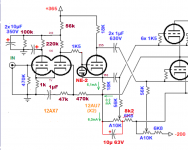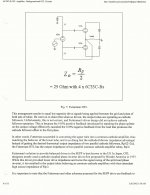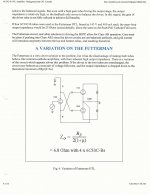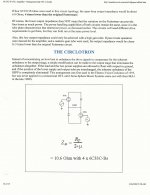@0.727 Total Harmonic Distortion: 2.142697%(2.145933%)
Yes Stewart. That's because the component models are far from being complete, and the wiring impact (capacitance, inductance and EMI) is very important on the end result.
I use them as guideline, but the real world is the ultimate test.
Yes Stewart. That's because the component models are far from being complete, and the wiring impact (capacitance, inductance and EMI) is very important on the end result.
I use them as guideline, but the real world is the ultimate test.
@0.727 Total Harmonic Distortion: 2.142697%(2.145933%)
Yes Stewart. That's because the component models are far from being complete, and the wiring impact (capacitance, inductance and EMI) is very important on the end result.
I use them as guideline, but the real world is the ultimate test.
Thanks @Brice 😉
Yes, I estimated by my experience a THD at circa 1-3%, sure less than 5% at max power, looking at the scope waveforms (vs. when I had my real-time THD software). So we are in the ballpark...
My prototype wiring being as short as direct possible, I think I avoid as best adverse wiring influences.
That bandwith drop remains suspect. Let's investigate now... 😉
Wait and See !
A+!
OK, here is a compleet newbie question:
What do I need to change to use 6SL7 tubes instead of the 12ax7?
What do I need to change to use 6SL7 tubes instead of the 12ax7?
OK, here is a compleet newbie question:
What do I need to change to use 6SL7 tubes instead of the 12ax7?
Nothing.
A+!
OK, here is a compleet newbie question:
What do I need to change to use 6SL7 tubes instead of the 12ax7?
Change the socket.🙂
Not very nice Mona , and the second half of 12AX7 will suffer till the output voltage "stabilized" to zero .
Last edited:
Explain ?Not very nice Mona , and the second half of 12AX7 will suffer till the output voltage "stabilized" to zero .
If you are concerned with the grid-cathode voltage, the speaker holds the voltage down.
The grid-cathode of the 12AU7 is in danger without a Ne bulb or a protection diode.If the power is there before the tubes heat there is over 300V.
Mona
It is a very bad idea to connect the speakers without a protection relay , all tube OTL amps must have this relay in the output , only when the output voltage set to zero , only then the relay connects the speakers to the amp , till that happens the bad start up of the output tubes, will "shake" the input tube ! .
What has that got to do with a suffering 12AX7 😕It is a very bad idea to connect the speakers without a protection relay , all tube OTL amps must have this relay in the output , only when the output voltage set to zero , only then the relay connects the speakers to the amp , till that happens the bad start up of the output tubes, will "shake" the input tube ! .
And no, no protection needed, read the hole treat.
Mona
@Ketje : yes, I checked the voltage accross p-k of the 12AU7 at the powering : it reaches circa 350V. But the Ua0 of the ECC82 is 550V, so no danger for that tube IMHO.
I discovered from where comes that suspect deep bandwith drop :
1 - Rp increase from 100K to 220K
combined with :
2 - non decoupled Rk.
Here are the values (@-3dB, with ref. 440Hz sinus / 16R / 10.00V output) :
Rp=100K Rk=560R no Ck : BP =150KHz
same as above, plus Ck=470µF : BP = 220KHz
Rp = 220K Rk=1K5 no Ck : BP = 70KHz
Same as above, plus Ck=470µF : BP = 130KHz
I tested several 12AX7 tubes, and the results in sensivity, output power and bandwidth are very close. Finally and surprisingly, the best performance is obtained with the original circuit Rp=100K Rk=560R Ck=470µF. I'll try with an higher impedance source than my 600R generator output, for confirmation.
And yes, @Dimitris AR : no need of a protection relay here. I can power on and off my prototype with a speaker connected without noting any significative movement of the cone, if I do not use the SBY switch (which shorts the speaker output).
I have some other ideas for the preamp stage - and I'll look tomorrow more accurately to your last suggestion @Ketje, who knows ...
A+!
I discovered from where comes that suspect deep bandwith drop :
1 - Rp increase from 100K to 220K
combined with :
2 - non decoupled Rk.
Here are the values (@-3dB, with ref. 440Hz sinus / 16R / 10.00V output) :
Rp=100K Rk=560R no Ck : BP =150KHz
same as above, plus Ck=470µF : BP = 220KHz
Rp = 220K Rk=1K5 no Ck : BP = 70KHz
Same as above, plus Ck=470µF : BP = 130KHz
I tested several 12AX7 tubes, and the results in sensivity, output power and bandwidth are very close. Finally and surprisingly, the best performance is obtained with the original circuit Rp=100K Rk=560R Ck=470µF. I'll try with an higher impedance source than my 600R generator output, for confirmation.
And yes, @Dimitris AR : no need of a protection relay here. I can power on and off my prototype with a speaker connected without noting any significative movement of the cone, if I do not use the SBY switch (which shorts the speaker output).
I have some other ideas for the preamp stage - and I'll look tomorrow more accurately to your last suggestion @Ketje, who knows ...
A+!
Last edited:
The voltage between grid and cathode is way to high at power up with cold tube.@Ketje : yes, I checked the voltage accross p-k of the 12AU7 at the powering : it reaches circa 350V. But the Ua0 of the ECC82 is 550V, so no danger for that tube IMHO.
Vgk is max 150V for the 12AU7.A small Ne bulb will prevent a high voltage, it ignites at ~70V.Ones the tube heats up the voltage drops to only 10V and the Ne is out of the circuit.
Since the starting high voltage is with positive grid and later on the grid gets negative, a diode can also be used but has more capacitance.
And a bulb looks nicer in a tube amp 🙂
Mona
All of this is much easier in a differential layout such as used by Atmosphere.🙂
What exactly are you referring to? Biasing the driver tubes? Need for DC protection at speaker outputs? Something else? The need for asymmetric drive of the Futterman output?
(I am asking because I do like the symmetry of the Circlotron as used by AtmaSphere, but I don't see the link to this thread)
What exactly are you referring to? Biasing the driver tubes? Need for DC protection at speaker outputs? Something else? The need for asymmetric drive of the Futterman output?
(I am asking because I do like the symmetry of the Circlotron as used by AtmaSphere, but I don't see the link to this thread)
Simply a comparison of topologies. Each has trade offs & advantages. In this case the differential approach has slightly higher source resistance than that in this thread. But much easier to realize a stable cct, both from an AC to a DC perspective. The diff version can be done with two PS + heaters. Simply an easier path to follow.
As I said earlier in the thread I built the GranDaddy of the cct in this thread, it needed the entire 40 db of gain used as NFB to get a reasonable D% number.
About 15-20 yrs ago a built an experimental vers of the diff vers. But I used an OPT, that avoided many of the problems of the OTL cct. Using PP KT88s or 6550s it managed an easy 57 watts. As part of the experiment I tried three different OPT arrangements. All published in AudioXpress magazine, can't recall which issue off the top. I've put it into a large PDF, if you like let me know your email, I'll respond.🙂
The OPT in the diff cct is 1/4 the Z of regular PP, the problems with leakage inductance are greatly reduced.
Like all my other recent stuff this one sits on the shelf, unused. Music is now background, my hearing is shot!! My daily driver in the workshop uses a 6AU6/6AQ5 FB pair. A whole 3W! And in my office a Sansui AU717 with matching TU717 Tuner.😱
Attachments
What has that got to do with a suffering 12AX7 😕
And no, no protection needed, read the hole treat.
Mona
If you insist on having the speakers connected continuously to the amplifier then your speakers may have a problem when you turn on the amp , it may be correct that the impedance of the speakers will minimize the voltage of the tubes during start up , but don't forget that in the schematic we have parallel 6080 tubes , which mean low output impedance an high current so I suggest not to do that .
In case you put a delay relay then all the output voltage ( during start up )will appear in the input of the12ax7 because you don't have a DC path to ground only AC , I hope now you understand what I mean !!😀 . In general I would say that the whole design of the input stage is wrong , very low gain and high distortions .
Excellent hybrid OTL ...
https://digilander.libero.it/el840/LIMPIDO.htm
Really? With a capacitor in the speaker path?
- Home
- Amplifiers
- Tubes / Valves
- The ultimate OTL6080




